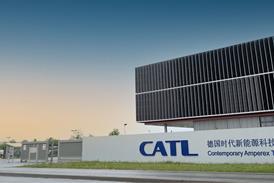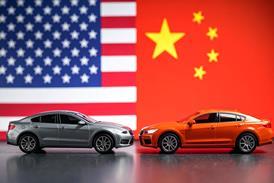
Signs of relief have finally come to American shores, and OEMs at this year’s conference promised big changes for the supply chain from lessons learned along the way. But what will it all mean for LSPs?
The 10th Automotive Logistics Global conference in Detroit revealed a North American industry slowly getting back on its feet, with economic indicators pointing toward a slow and shaky recovery. While the sharp rise in vehicle sales during August, spurred by the government-sponsored ‘cash for clunkers’ initiative, was followed immediately by a September collapse when the programme ended (40% lower than August, and 25% off September 2008), October sales showed a less than 1% decrease from 2008, and November sales were flat. And with economic data showing a return to GDP growth, analysts are forecasting growth from there.
JD Power’s Jeff Schuster, executive director for forecasting, predicted that the combined retail and fleet sales for passenger cars in the US would fall to 10.3m in 2009 (from 13.2m in 2008, and 16.1m in 2007), a large drop but nevertheless an improvement over a seasonally-adjusted annual rate (SAAR) that had fallen as low as 8m units earlier this year. But Schuster suggested there is substantial pent-up demand in the US, as consumers have saved more money, more drivers take to the road and an aging car parc is renewed – he suggested the US could see 15m units in sales again by 2012.
While some at the conference were decidedly less optimistic, those figures would excite most logistics service providers, as would Schuster’s indication that carmakers are investing again: there will be 217 new launches over the next three years. Those new models, whether imports or new production runs, often represent opportunity for providers in tenders.
 But questions remain over what this potential recovery will look like for the supply chain. The North American market, like the global industry, is facing huge shifts in power, capacity, products and costs. The Detroit carmakers, for example, began this decade with capacity for 15m units per year, which fell to 12.2m in 2008, and will drop again to 9.7m by 2012, according to Schuster. European, Korean and Japanese transplants will replace it, perhaps more aggressively as the dollar declines. Another wildcard could be the entry of an Indian or Chinese carmaker, although analysts at the conference did not see this happening in any substantial way during the next five years.
But questions remain over what this potential recovery will look like for the supply chain. The North American market, like the global industry, is facing huge shifts in power, capacity, products and costs. The Detroit carmakers, for example, began this decade with capacity for 15m units per year, which fell to 12.2m in 2008, and will drop again to 9.7m by 2012, according to Schuster. European, Korean and Japanese transplants will replace it, perhaps more aggressively as the dollar declines. Another wildcard could be the entry of an Indian or Chinese carmaker, although analysts at the conference did not see this happening in any substantial way during the next five years.
 Other changes suggested at the conference include a shift toward lower inventory levels, smaller, less profitable vehicles, alternative powertrain technology, and a more active role by the US government, not only in terms of its partial ownership of GM and Chrysler, but also regulation that could impact global trade, carbon emissions and energy prices.
Other changes suggested at the conference include a shift toward lower inventory levels, smaller, less profitable vehicles, alternative powertrain technology, and a more active role by the US government, not only in terms of its partial ownership of GM and Chrysler, but also regulation that could impact global trade, carbon emissions and energy prices.
American on the outside, global inside
While there could be more vehicle assembly localised in the US, production and sourcing continues to take a global focus, as Ford and GM are trying to catch up with other carmakers by shifting to more global platforms. Ford, for example, will begin production of its Europe-based Focus next year in Dearborn, replacing the current North American model. According to Joe Hinrichs, who spoke as the group vice president, global manufacturing and labour affairs, but has since been made Ford’s group vice president of Asia Pacific and Africa, the new Focus has much more global content than the current model, and will see about 200 containers arrive in US ports per week, versus 20 for the current Focus.
Along with expansion of the supply base, and investment in future capacity in India and China, Hinrichs said that Ford, “is now acting like a global company in a way it hadn’t before.”
According to Rick DeMuro, director of MP&L for Asia Pacific, Ford’s capacity will treble in Asia Pacific by 2013 to 1.5m units. He pointed out that in these markets, logistics plays a critical role in both determining locations and in manufacturing strategy. “This is a growth opportunity for the Ford Motor Company,” he told delegates.
Similarly, MM Singh, managing executive officer for production at India’s largest carmaker, Maruti Suzuki, told delegates that he had travelled to Detroit because he wants to learn and work with the best. “Automotive logistics is not at the level that we want in India,” he said. “I want to work with you, and I’m looking for your participation about what we can do together to develop world-class logistics.”
Such changes will offer opportunities for logistics providers able to meet the global needs of Ford, Maruti and other OEMs, while likewise these seismic shifts will potentially hurt some providers operating at a more local level. Singh acknowledged that he had yet to see any real commitment from a global LSP in India. NYK Europe’s executive vice president, Svein Steimler, warned that if American or European companies did not act soon, those new markets would be dominated by local logistics players.
Will the supply chain be electrified?
Other opportunities or threats could come from the potential changes that will result from electric and hybrid vehicles, with the up-and-coming launch of GM’s Volt and Nissan’s plans for electric battery and vehicle production in Tennessee. Susanna Webber, executive director of global logistics for GM, said that it has been time consuming to understand all the requirements that electric and hybrid vehicles present for logistics. Toyota North America’s manager for logistic control, Denny Lewis, said that, while in its infancy in the US, Toyota knew from building and sourcing batteries in Asia that it also represents a tremendous amount of logistics cost.
 But this development could present LSPs with new business spinoffs, from battery handling and specialised packaging to new methods for the aftermarket and finished vehicle logistics, such as moving batteries separate from the vehicles. With the total change in the scope of an engine, including almost no moving parts, it could mean a much different and less dynamic supply chain for an LSP, as well as a different aftermarket. But if the conference was any indicator, any such developments are a long way off, and there is not much forward planning being done in conjunction with LSPs (which is another, perhaps worrying indication of the level of partnership between OEMs and LSPs).
But this development could present LSPs with new business spinoffs, from battery handling and specialised packaging to new methods for the aftermarket and finished vehicle logistics, such as moving batteries separate from the vehicles. With the total change in the scope of an engine, including almost no moving parts, it could mean a much different and less dynamic supply chain for an LSP, as well as a different aftermarket. But if the conference was any indicator, any such developments are a long way off, and there is not much forward planning being done in conjunction with LSPs (which is another, perhaps worrying indication of the level of partnership between OEMs and LSPs).
Meanwhile, the US remains a petrol-driven economy with a vehicle mix that remains considerably larger than most other parts of the world. While the compact car market has climbed to 40%, according to JD Power, it is a long way off the global average of 60%. Meanwhile, the A and B segments, such as the kind Ford produces in Europe and Maruti in India, barely exist in the US.
Low inventory… for a moment or two
The more immediate, pervasive change discussed at the conference was a shift toward smaller inventories for finished vehicles. On September 1st, vehicle inventory across the US was at 30 days compared to peaks of 120 days at the worst point of the crisis, and above 70 at the same time in 2008.
 While the past 20 years have seen inbound logistics and production refined to just hours of inventory, with delivery slots no more than 15 minutes, the industry has financed a glut of vehicle inventory that has averaged nearly twice the average 40 days found in retail, according to Schuster.
While the past 20 years have seen inbound logistics and production refined to just hours of inventory, with delivery slots no more than 15 minutes, the industry has financed a glut of vehicle inventory that has averaged nearly twice the average 40 days found in retail, according to Schuster.
However, the unprecedented drop in sales, and the Detroit bankruptcies and shutdowns, allowed carmakers to make bolder production cuts than ever before. Hinrichs, acknowledging the industry had carried too many vehicles for years, revealed that Ford’s 29% reduction in inventory has meant savings of $1.5 billion. “That’s the impact that our [supply chain and production] organisation can have,” he said.
Hinrichs added that Ford would not return to the old days of running factories just for the sake of it, and would instead begin manufacturing plans “at the dealers”. He indicated that given the choice between holding too much stock and stopping the line, Ford would choose the latter. “We have come a long way on total landed cost, and on being able to make a decision on when we can shut down the line,” he said.
However, it might be too soon to predict just how significant the inventory shift will be. Inventory levels doubled during September to 60 days (66 for the Detroit Three) by October 1st, when sales slumped, and increased again during October, according to the Automotive News Data Center.
But the anticipation for inventory reductions can be measured by production figures that are and will remain considerably more subdued than sales; JD Powers predicts 2009 will finish at 8.5m cars (from 12.6m in 2008), lagging well behind any sales recovery next year, and production might not reach 15m units again until 2014.
Webber said GM sees this inventory change as permanent, rather than a side effect of the recession. “When we talk about finished vehicle inventory, it is definitely more of a permanent change, adjusted to the market demand,” she said. “That impacts us on the material side to be smarter and faster.”
 Nissan North America’s Mike Steck said that OEMs have learned an important lesson and will try to manage the supply chain more tightly in future. “I believe we’ve recognised that we don’t need as many units in central stock, but need a lean environment where we have vehicles coming out of the factory today that are due to a dealer order tomorrow,” he said. “Intuitively we like what is happening in that dynamic and want to keep a pull rather than a push system into the market.”
Nissan North America’s Mike Steck said that OEMs have learned an important lesson and will try to manage the supply chain more tightly in future. “I believe we’ve recognised that we don’t need as many units in central stock, but need a lean environment where we have vehicles coming out of the factory today that are due to a dealer order tomorrow,” he said. “Intuitively we like what is happening in that dynamic and want to keep a pull rather than a push system into the market.”
If the change does stick, it could mean lower turnover for logistics companies fuelled by material throughput in factories, warehousing and vehicle volumes. However, the ability to keep the supply chain running smooth and lean is what will catch the OEMs’ attention. “This year, if you want to be heard, you have to tell the OEM that you can help lower cost, provide ‘pay as you go’ service and lower inventory,” said IT-provider i2’s Kelly Thomas, senior vice president of product strategy.
Denny Lewis described Toyota’s approach to inventory as that of a baseball “strike zone,” where manufacturing, sales and logistics have to work closely together to find the right balance between too much or too little inventory. He acknowledged that the communication between those aspects of the supply chain within Toyota had become more important. Perhaps tellingly, the Japanese OEM retains the lowest stock in the sector, and its inventory between September 1st and October 1st grew much less than other OEMs, from 12 days to 19.
Leaner logistics organisations too
GM’s Webber and the other carmakers pointed to further change at OEMs, with slimmer supply chain organisations and more centralised management where boundaries were thinner between production, logistics, sales and marketing.
“Communication has opened up across work groups and plants, with a lot more cross functions,” said Honda of America’s Dana McBrien, associate chief adviser for transportation and systems. “I’ve learnt more about sales than ever before, and that line connecting the supply chain has become more critical. The dynamics have changed and they are probably going to stay that way.”
Mike Steck acknowledged a similar change in Nissan’s supply chain organisation. “Years ago, the supply chain group were simply order takers, building x amount of widgets and putting them in inventory,” he said. “Now, I don’t think a day goes by without sometimes heated discussion with sales and marketing. That cross function has been key for us and for my team to learn sales and marketing better.”
During the restructuring and bankruptcy, Webber said her department had at least three rounds of staff cuts and changes (a restructuring that was similar at GM’s co-bankrupt colleague, Chrysler), which has seen certain work functions put under her team’s responsibilities, including container management, warehousing and sequencing, as well as a closer alignment with purchasing and sales. The team has also gained more global roles.
“Typically in the States our logistics team was more domestic focused, with an intercontinental division,” she said. “Now we’ve had to combine that function. We’ve also linked procurement more closely with operations.”

How to find the way to profitability again
This potential inventory shift will be good for the industry’s profitability. David Cole, from the Center for Automotive Research, suggested that the Detroit Three were curing themselves of “a slow-growth cancer” during the recession, including eliminating labour disadvantages with transplants, reducing excess production capacity, holding lower inventory and overseeing a gradual return of pricing power. “It has been a buyer’s market for ten years, but now with lower inventory there is a slow transition to more of a seller’s market.
“We could see the most profitable period since the end of World War II,” he said.
.jpg) That was welcome optimism, but it would of course depend on many mitigating factors, not least the strength of any recovery. But lower inventory will not continue without a struggle (as September and October demonstrated). Ford’s Hinrichs acknowledged how the pursuits of supply chain management can sometimes come into conflict with one another. “We want less inventory, but more global parts and we want to move quicker,” he said. “If you drain the supply base and then become more global, it is a tough equation.”
That was welcome optimism, but it would of course depend on many mitigating factors, not least the strength of any recovery. But lower inventory will not continue without a struggle (as September and October demonstrated). Ford’s Hinrichs acknowledged how the pursuits of supply chain management can sometimes come into conflict with one another. “We want less inventory, but more global parts and we want to move quicker,” he said. “If you drain the supply base and then become more global, it is a tough equation.”
Steck said that lower inventory was exposing some cracks in the foundation, which in the long run would be good for OEMs. “The inventory situation has put a stress on the supply chain that exposes all sorts of problems that have been there for 20 years,” he said. “It could be throughput problems at the port related to timetables, or a vanning project from Asia. But this lean environment is creating healthy tension in exposing those areas.”
 One obvious caveat to this lean approach, which went relatively unmentioned during sessions, would be a greater need for premium freight to speed up production or vehicle delivery. Some OEMs also admitted privately that, although production was down dramatically, premium freight had reached levels that matched peak years of production in 2006 or 2007.
One obvious caveat to this lean approach, which went relatively unmentioned during sessions, would be a greater need for premium freight to speed up production or vehicle delivery. Some OEMs also admitted privately that, although production was down dramatically, premium freight had reached levels that matched peak years of production in 2006 or 2007.
Ford’s Hinrichs stressed the importance of visibility in the supply chain, for both parts and finished vehicles. “We need visibility for the whole supply chain, not just that a part is on a dock or on a ship,” he said. “We need to know exactly where it is, because we might need it suddenly.
“It is the same for vehicles,” he added. “It is not enough to know that the car cleared customs, we need to know exactly where it is because otherwise we could lose that sale.”
The fear of losing that sale by drawing from inventory stocks that fall below the “strike zone”, is what might ultimately lead carmakers back into a higher inventory environment. NYK’s Svein Steimler challenged the idea that extending the lead times for vehicles would actually result in lower sales. “Sometimes we have a tendency to over-dramatise this issue of logistics,” he suggested. “People don’t buy a car on the basis of logistics – as long as [the logistics] work, it is okay. Would increasing your lead times really impact your sales negatively?”

But carmakers showed almost no interest in increasing vehicle lead times or moving toward a built-to-order (BTO) environment, where cars are produced on end customer demands, rather than by dealer stock or by OEM pushes. “The lead time for a vehicle delivery is very important,” said Webber. “You want that strike zone or else you lose that opportunity. It is the one element that you cannot reduce.”
Steck said he was certain carmakers in the US could lose sales if inventory fell too low and lead times were increased. “In a built-to-stock environment [like in the US], you absolutely could lose sales by delaying delivery times, although you wouldn’t lose much in a BTO environment,” he said.
 He cited studies showing that only about 5% of Americans would be interested in a BTO model. While he acknowledged that the current crisis means that this percentage might have risen – perhaps to 15% of consumers – he doubted whether it would ever be an overwhelming percentage. He suggested instead that OEMs had to watch carefully its dispersion of vehicles on dealer lots, balancing between fast moving, low complexity vehicles, and slow moving, high complexity vehicles. “When you are at low inventory levels, and you have a highly complex vehicle like an SUV with two or three rows of seating, front or rear wheel drive, etc, then the customer might not even see an example of what he wants on the lot,” he said.
He cited studies showing that only about 5% of Americans would be interested in a BTO model. While he acknowledged that the current crisis means that this percentage might have risen – perhaps to 15% of consumers – he doubted whether it would ever be an overwhelming percentage. He suggested instead that OEMs had to watch carefully its dispersion of vehicles on dealer lots, balancing between fast moving, low complexity vehicles, and slow moving, high complexity vehicles. “When you are at low inventory levels, and you have a highly complex vehicle like an SUV with two or three rows of seating, front or rear wheel drive, etc, then the customer might not even see an example of what he wants on the lot,” he said.
Later, he added: “On a low volume product, carrying 60 days of supply might not even get you one per dealer, so you have to understand what you want to do strategically.”
For Steck, the most important indicator in balancing vehicle supply is the consignment rate, which is the percentage of units that Nissan is building for stock, versus those that have a known dealer order already. “That is currently about 99% [dealer orders],” he said. “When we start to see consecutive snapshots when that figure is deteriorating, then we will pull back production.”
Aftermarket needs to change ‘entitlement system’
Breakout workshops during the conference also revealed changes happening in the aftermarket. Dan Ferrell, Nissan’s director of spare parts logistics, said that his biggest challenge was what he called the “entitlement system”, which included dedicated deliveries to 75% of Nissan dealers.
“Our dealers like the service, but times have changed and cost has changed, which has brought problems,” he said. “The 25% not getting direct deliveries usually want something other than LTL [less than truckload].”
Other OEMs and LSPs in the aftermarket agreed. Tom Ross, from Exel, wondered if an environment that saw lower part sales – partly a result of the economy and cars becoming more reliable – presented an opportunity for a move toward LTL, or even a different transport mode. Ferrell agreed, but said that it would be “brain surgery” both in changing dealer attitudes and also finding new options from providers.
There was also discussion of shared warehousing and distribution centres, although Ferrell acknowledged that the industry hadn’t really “drank the kool-aid yet” on such collaboration because the company was committed to a labour strategy that made it difficult to work with other companies.
Ford’s Roger Huff, responsible for spare parts logistics, stressed that the industry had to re-evaluate its processes. Certain shared linehauls might not have been considered before because they might have delayed delivery by some hours. “But if we communicate more with our dealers, we might be able to realise that a 12:00 delivery is just as good as a 10:00 one,” he said. “That could allow more collaboration.”
His words echoed those of Honda’s Dana McBrien, who stressed that network planning would need a constant focus, and LSPs and OEMs would need to be more flexible. “It is not that our old logistics processes are totally broken,” he said. “But many are no longer relevant”







































